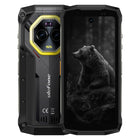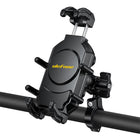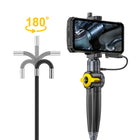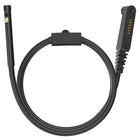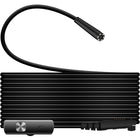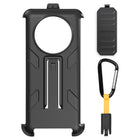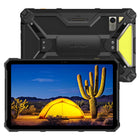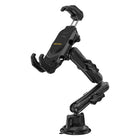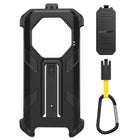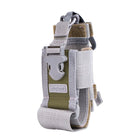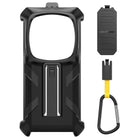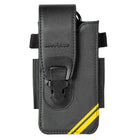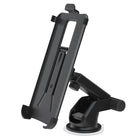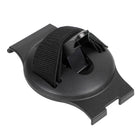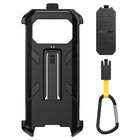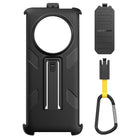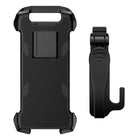Thermal Camera Applications Electrical
Electrical Thermal Camera Applications
Thermal cameras are an extremely effective tool for testing electrical systems for component damage, excessive heat and for ensuring overall system efficiency. They can be used absolutely everywhere from domestic installations to testing inside complex industrial-based systems, making them an incredibly versatile testing tool.
Everything from our common electrical appliances to complex electrical systems running industrial-grade machinery rely on their components and the safe introduction of electricity into the system in order to run efficiently. Component breakdown or inefficiently running electrical systems can be both a costly process due to the amount of excess power used and can also result in an electrical system becoming increasingly unsafe to be utlised.
Testing electrical systems regularly is therefore of the utmost importance, particularly when downtime or excessive running costs could be extremely costly to the organisation. Regular testing of components can involve using conventional tools such as multimeters and other electrical test equipment, but these generally are much more complex to use and require extensive testing to be carried out. This means a lot of time can be wasted testing components that are perfectly fine, which again can be a costly process.
In comparison using a thermal imaging system is quick, easy and requires little effort on the part of the user. We'll get more into the benefits of using these devices later, but it is important that you understand how thermal cameras work before we delve further into electrical thermal camera applications.
What Is a Thermal Camera and How Does It Work?
If you're brand new to thermography, understanding exactly what these devices are and how they work is extremely important. If you want the complex way of putting it, a thermal camera records the intensity of radiation in the infrared part of the electromagnetic spectrum and converts it directly into a visible image. In simpler terms, this means that a thermal camera detects IR light (which is completely invisible to humans) and uses this information to display an image that shows the different temperatures in an environment.
But what is IR light? Well, basically IR light is expressed mainly through IR radiation which is output as heat via an object. Everything from our own bodies to basic items around us pumps out IR radiation constantly and the thermal imaging camera is able to pick up on this distribution (known commonly as 'emissivity') and show the temperature differences in an environment as a thermal image. Even extremely cold objects, such as a block of ice or an ice cube, still output IR radiation.
Thermal cameras are able to utilise the infrared energy put out by objects and convert it directly into an image. This is carried out by focusing IR light by the use of the cameras optics onto an infrared detector. This information is then sent to sensor electronics for image processing and this translates the detected information into an image where every pixel represents a temperature measurement. Depending on the amount of pixels capable of being displayed by the camera this enables the user to gain comprehensive measurements of temperature in an area, all with the added benefit of not actually making contact with a surface.
Why Use a Thermal Camera for Electrical Testing?
The advantages of using thermal imaging systems in electrical applications are vast. As mentioned briefly previously, the thermal camera excels in this environment as a preventive maintenance tool, enabling users to carry out temperature diagnostics of critical machinery without the need to carry out measurement using conventional thermometers.
That's all well and good, but thermal cameras also have a number of other benefits that can be of use in the electrical industry. These include easy-to-use interfaces and design, full images of your testing area, quick and easy problem diagnostics, full temperature measurements, storage of images and videos, calculation of what needs to be fixed without carrying out extensive testing and saving time/money by not wasting time with other testing procedures.
The following images show how electrical problems can be spotted using a thermal camera:

Poor connection with internal damage

An example of a damaged fuse

Incorrectly secured connection
As can be seen in these images, incorrectly installed applications or damaged components generally output an excessive amount of heat. The white colouring you can see on these images shows that these sections of the image are extremely hot, thus showing that something isn't working correctly in the system. If a thermal camera wasn't used in this case these problems might go completely unnoticed or require extensive testing of a system to find the problem. A thermal camera simply detects the problem within seconds and stores the image for easy reference at a later date.
The colour of something in a thermal image is determined by the overall heat of an object. The white is obviously the hottest part of the image, but the dull purples/blues show things that are not outputting much IR radiation. In the middle image above you can clearly see that two other fuses in the same system are working correctly while the third isn't due to its large heat output.
Electrical Panel Measurements
Need to test inside electrical panels but struggling due to having to switch off the system? Thermal cameras are a much more effective tool for measuring these devices and they can be used in combination with infrared (IR) windows to measure inside electrical panels without the need to even open up the panel in the first place.
This improves the testing signficantly as the panel in question can be tested while actually active. If powered down problematic electrical flow would likely go unnoticed, so carrying out testing using a combined thermal camera and IR window system is rapidly becoming adopted by larger companies as part of their maintenance routines.
Of course if an IR window isn't a possible solution, it is still possible to use a thermal camera to assess internal electrical panel components when the system is safely powered down and opened up. If problems are present within the components inside the panel this damaged component will more than likely be outputting excess heat; a thermal camera is able to pick up on this heat distribution and display the problem as a thermal hotspot.
Thermal Imaging Cameras Monitor overhead Lines in Delhi Metro Railways
Every day millions of commuters use the metros of Delhi. The Delhi Metro Rail Corporation (DMRC) sees to it that they are all arriving timely on their destination. Being service oriented and caring about their customers: that is what DMRC is all about. In order to keep the metro network up and running at all times, DMRC is using FLIR thermal imaging cameras.
The Delhi Metro is a rapid transit system serving Delhi, Gurgaon, Noida and Ghaziabad in the National Capital Region of India. The network consists of six lines with a total length of 189.63 kilometers with 142 stations of which 35 are underground. It has a combination of elevated, at-grade and underground lines and uses both broad gauge and standard gauge rolling stock. The Delhi Metro is built and operated by the Delhi Metro Rail Corporation Limited (DMRC). The metro has an average daily ridership of 1.8 million commuters and the DMRC operates around 2,700 trips daily between 6:00 and 23:00 running with an interval of 2 minutes 30 seconds between trains at peak frequency.
Predictive maintenance using thermal imaging
This large and intensely used network needs to be maintained well, to prevent the network to be worn due to the intense use, causing mayhem for millions of commuters. That is why the maintenance crews were already using thermal imaging cameras as part of the predictive maintenance program. Generally speaking all electronic equipment and components heat up before they break down. These potential problems will be clearly shown in a thermal image. By detecting this rise in temperature in an early stage using FLIR thermal imaging cameras, the maintenance crews can plan repairs and prevent costly failures and downtime. To that end all components of the railway network are regularly inspected by maintenance crews using a FLIR E50 thermal imaging camera. These periodic inspections play a crucial part in the DMRC’s preventive maintenance program.
Installation of a thermal imaging camera
When recently problems occurred in the metro railway network, which caused huge delays, DMRC suspected the problem was caused by the section insulators. The DMRC maintenance crew therefore installed one of their FLIR E50 thermal imaging cameras in an IP66 rated protective enclosure with Germanium infrared window to monitor the problematic section for an entire work day. Protected from adverse weather conditions by the protective enclosure the FLIR E50 thermal imaging camera was able to safely record the infrared radiation emitted by the section insulators and provide thermal images with each pixel corresponding to a non-contact temperature measurement.
The Composite Video Out of the FLIR E50 thermal imaging camera was linked to a Digital Video Recorder (DVR) with capacity of one Terabyte in order to record the data. After monitoring the section insulators for an hour the system writes a video file. These hourly video files were used to correlate temporary rises in temperature with the time of day, network load and other factors to determine the cause of the problem.
Causes found in thermal data
The installation of the protective enclosure with thermal imaging camera and DVR was done by FLIR products distributor M/s NNK International and DMRC staff. They performed the installation during the night to prevent hindrance to the metro users.
Tests were conducted at sites where the problems were severe and the results were recorded during the instances when the pantograph passes the section insulators. It was observed that factors like system load and environmental conditions played a big role in the deterioration of the section insulators. To further attribute the problem the thermal imaging camera was used to monitor the instances when the temperature of the section insulators went above a previously set threshold.
Careful analysis of the thermal data has allowed the DMRC to take the appropriate action. This thermal information has also helped DMRC to check the redundancy of its system during different weather and loading conditions for ensuring better services to its commuters.
What is a section insulator?
Section insulators are used on the overhead lines system (catenary structure) of railways to electrically isolate and separate sections for maintenance without having to turn off the entire system. The overhead line system is broken into electrically separated portions known as sections. Section insulators are also used extensively on change overs and can be used in conjunction to isolate sections in separate phases being fed by different feeder substations.
*Products with Thermal Imaging:
Armor 27T pro,Armor 25T Pro,Armor 25T, Power Armor 18T Ultra, Power Armor 19T, Power Armor 18T, Armor 11T 5G, Armor 9.







